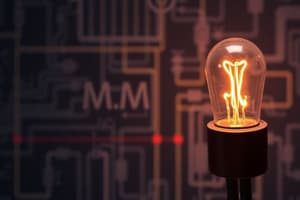Podcast
Questions and Answers
Which component is NOT typically used in electronic circuits?
Which component is NOT typically used in electronic circuits?
- Transistor
- Capacitor
- Microphone (correct)
- Resistor
Digital communication utilizes continuous signals.
Digital communication utilizes continuous signals.
False (B)
Name two types of signals used in electronics.
Name two types of signals used in electronics.
Analog and digital
In communication systems, bandwidth affects the types and rates of signals that can be transmitted. It is measured in __________.
In communication systems, bandwidth affects the types and rates of signals that can be transmitted. It is measured in __________.
Match the following electronic components with their functions:
Match the following electronic components with their functions:
Which technology is associated with controlling the flow of electrical power?
Which technology is associated with controlling the flow of electrical power?
Multiplexing allows different signals to share a single communication channel.
Multiplexing allows different signals to share a single communication channel.
What is the primary role of protocols in communication systems?
What is the primary role of protocols in communication systems?
Flashcards
Electronics
Electronics
The study and application of electric circuits and devices, like resistors, capacitors, etc., in various devices
Analog Electronics
Analog Electronics
Uses continuous electrical signals.
Digital Electronics
Digital Electronics
Electronics using discrete, binary signals.
Communication Systems
Communication Systems
Signup and view all the flashcards
Digital Communication
Digital Communication
Signup and view all the flashcards
Analog Communication
Analog Communication
Signup and view all the flashcards
Bandwidth
Bandwidth
Signup and view all the flashcards
Protocols
Protocols
Signup and view all the flashcards
Multiplexing
Multiplexing
Signup and view all the flashcards
Telecommunications
Telecommunications
Signup and view all the flashcards
Power Electronics
Power Electronics
Signup and view all the flashcards
Circuit Diagrams
Circuit Diagrams
Signup and view all the flashcards
Ohm's Law
Ohm's Law
Signup and view all the flashcards
Kirchhoff's Laws
Kirchhoff's Laws
Signup and view all the flashcards
Integrated Circuits
Integrated Circuits
Signup and view all the flashcards
Study Notes
Electronics
- Electronics deals with the study and application of electric circuits and devices.
- It involves a wide range of components, including resistors, capacitors, inductors, transistors, diodes, and integrated circuits.
- Key applications of electronics include computers, smartphones, televisions, and various other consumer electronics.
- The behavior of electrons in materials is fundamental to electronics. Electrical conductivity, semiconductors, and insulators play crucial roles.
- Analog electronics uses continuous signals, while digital electronics uses discrete, binary signals.
- Basic electronic designs involve understanding circuit diagrams, Ohm's Law, Kirchhoff's laws, and various circuit analysis techniques.
- Electronic components come in a wide variety of packages or configurations depending on the desired application.
- Power electronics controls the flow of electrical power, essential in many applications ranging from motor control to power supplies.
Communication Systems
- Communication systems transmit information from a sender to a receiver.
- Various methods of communication exist, including wired, wireless, and optical communication.
- Communication systems use various techniques for encoding and decoding information, such as modulation and demodulation.
- Communication channels can be affected by noise and interference.
- Digital communication uses discrete signals, typically encoded as binary data.
- Analog communication uses continuous signals, such as sound waves.
- Bandwidth and frequency are crucial concepts in communication systems. The bandwidth of a channel affects the types and rates of signals that can be transmitted.
- Protocols are established sets of rules or standards that govern communication between devices.
- Different communication standards and technologies are used for various applications, including internet communications, television broadcasts, and mobile networking.
- Multiplexing allows different signals to share a single communication channel.
- Telecommunications involves transmission of information over long distances (e.g., telephone, internet, radio).
- Cryptography plays a role in secure communication.
- Signal processing techniques are essential for improving the quality of transmitted signals and reducing noise.
Integration of Electronics and Communication
- Modern technologies often integrate electronics and communication to create complete systems.
- For example, a smartphone uses components like processors and memory (electronics) to process data and communicate with other devices (communication systems).
- Modern communication relies heavily on electronic devices and circuits.
- The increasing miniaturisation of electronic components facilitates the development of devices that combine complex communication functions and powerful computing characteristics.
- Wireless communication technologies utilize electronic devices for radio waves' generation, transmission, and reception—a combination of both areas.
- Specialized electronic circuits are designed for encoding, decoding, and processing signals.
Studying That Suits You
Use AI to generate personalized quizzes and flashcards to suit your learning preferences.




